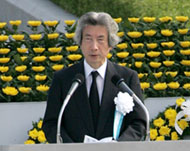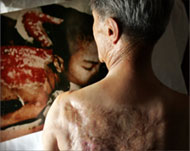Nagasaki survivors urge nuclear ban
The Japanese city of Nagasaki is marking the 60th anniversary of becoming the second city to suffer an atomic attack, by calling on the US to give up its nuclear arsenal.

Three days after the world’s first atomic bombing reduced Hiroshima to ruins, a second bomb, code-named Fat Man after Winston Churchill, hit the hilly southern port of Nagasaki, killing more than 70,000 people.
About 6000 people including Prime Minister Junichiro Koizumi began with a minute of silent prayer at 11.02am (0202 GMT) on Tuesday, 60 years to the moment the plutonium bomb was dropped on 9 August 1945.
“To the citizens of America: We understand your anger and anxiety over the memories of horror of the 9/11 terrorist attacks,” Nagasaki Mayor Iccho Ito told the ceremony in the city’s peace park.
“Yet, is your security actually enhanced by your government’s policies of maintaining 10,000 nuclear weapons, of carrying out repeated sub-critical nuclear tests, and of pursuing the development of new ‘mini’ nuclear weapons?” Ito asked.
“We are confident that the vast majority of you desire in your hearts the elimination of nuclear arms. May you join hands with the people of the world who share that same desire and work together for a peaceful planet free from nuclear weapons,” he said.
Non-nuclear commitment
Koizumi, who flew to Nagasaki despite a political crisis in Tokyo where he has called early elections, made nearly identical remarks to his statements on Saturday in Hiroshima, where more than 140,000 died in the world’s first nuclear bombing.
 |
|
Junichiro Koizumi: Japan will |
“I give all my heart to the victims,” Koizumi said.
“Japan will make an effort to keep world peace and maintain the three non-nuclear principles and a peaceful constitution,” he added.
He was referring to Japan’s 1967 commitment not to produce, possess or allow the entry into its territory of nuclear weapons.
Koizumi, who faces a new election on 11 September, has favoured revisions to the US-imposed 1947 pacifist constitution to recognise that Japan has a military.
Tuesday’s remembrances began just after sunrise, hundreds of Catholics joined in a special Mass at Urakami Cathedral, which at the time of the bombing was the largest in Asia with 12,000 parishioners – 8500 of whom are believed to have been killed.
Not primary target
When the cloudy sky lit up in a sudden flash at 11.02am, two priests were hearing confessions inside the cathedral and 30 faithful were inside. Everyone in the church died and the statues around them turned black because of the intense heat.
 |
|
Adults and children alike were not |
Ironically, Nagasaki was not a primary target.
Three days after the Enola Gay dropped the “Little Boy” bomb on Hiroshima, killing at least 140,000 in the world’s first atomic bomb attack, Bock’s Car took off to deliver the second A-bomb to the nearby city of Kokura.
Kokura was hidden under a thick cover of smoke. The plane circled three times, then changed course for Nagasaki, where it also encountered thick clouds.
With dwindling fuel, the pilot nearly turned around – but then the clouds broke.
Japan surrendered on 15 August 1945, ending the second world war.
Bodies not found
Nagasaki’s devastation has been overshadowed by Hiroshima, where about 55,000 people swarmed into that city’s Peace Memorial Park to mark the 60th anniversary of the attack last week.
 |
|
A moment of silence was observed |
The people in Nagasaki, however, have not forgotten.
“Together with some 260,000 A-bomb survivors … I swear in the presence of the souls of the victims of the atomic bombing to continue to tirelessly demand that Nagasaki be the last A-bomb site,” said Fumie Sakamoto, who represented the survivors at Tuesday’s memorial.
Sakamoto was a junior high school student when Nagasaki was bombed. The remains of thousands of the dead have never been found.
Estimates of the toll itself range from 60,000 to 80,000. Nagasaki officials on Tuesday said the death figure was 74,000.
Throughout the worst-hit parts of the town, thousands of colourful paper cranes, which are believed to ease the pain of the dead, were draped over stone monuments dedicated to the victims.
A steady stream of tourists also flowed into Nagasaki’s A-bomb museum, where horrific reminders of the attack cover the walls; a broken clock with its twisted hands stopped at the instant of the blast; photos of the dead or the burned.
Exhibits
 |
|
Some victims still bear not only |
In sharp contrast with the museum at the controversial Yasukuni war shrine in Tokyo, which has been widely criticised as one-sided in favour of Japan’s wartime leadership, the Nagasaki museum is careful to place the attack firmly in its historical context.
Visitors see a timeline of Japan’s own military adventures, and exhibits note Tokyo’s alliance with Nazi Germany.
The final hall is taken up by appeals for the abolition of all nuclear weapons.
New life
Other than the many small monuments around town, few signs of the devastation remain in Nagasaki.
A scenic port city with a population of about 420,000, it is today a popular tourist destination known for its
Chinatown – one of the largest in Japan – and somewhat European flair.
For about 200 years, until Japan opened its doors to the outside world in 1859, it was the only Japanese city open to foreign trade.